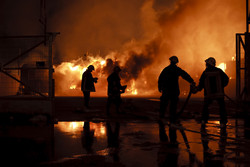Detecting explosive threats with cutting edge imaging
EU-funded researchers are developing technologies capable of detecting the presence of explosives and hazardous materials. The ultimate goal is to create new tools that will help law enforcement agencies protect civilians and ensure that dangerous workplaces – such as oil rigs and chemical plants – are as safe as possible, with minimal risk to safety personnel. The EUR 3.35 million CHEQUERS project, which began in March 2015, brings together laser experts and law enforcement agencies. The potential for new industrial applications of advanced detection technology is huge, with security measures across Europe constantly being tightened. The ability to detect explosives and chemical warfare agents quickly and accurately from a distance would be of huge interest to the security sector. Furthermore, the prevention of potentially catastrophic leaks in the oil and gas industry could not only save many lives in the future, but also enable the energy industry to avoid massive fines and clean-up costs following a disaster. In January 2015, a US federal judge estimated that the oil spilled into the Gulf of Mexico as a result of rig explosion in 2010 could end up costing oil giant BP more than $ 13 billion (EUR 11.7 billion). Very often, prevention is the best cure. The CHEQUERS project is working to develop what are known as ‘standoff’ detection tools, which would give security personnel the ability to detect, for example, explosives in a vehicle or a package from distances of up to a few hundred metres away. Project partners are working to develop final products that will include handheld and tripod-mounted instruments based on active hyperspectral imaging and detection. Hyperspectral imaging collects and processes information from across the electromagnetic spectrum, with the aim of finding objects and identifying materials not visible to naked eye (certain objects leave unique 'fingerprints' in the electromagnetic spectrum). These instruments will allow for the rapid detection of explosive, toxic, or otherwise hazardous materials related to terrorist attacks or industrial accidents. Within the lifetime of this project, these tools will be refined and evaluated by the project’s civil security partners, who will implement them in a number of likely end-use scenarios. This will enable a more accurate evaluation of the potency and utility of the technology, and help to ensure that final products are as cost-effective and user-friendly as possible. The cooperation within CHEQUERS underlines one of the key strengths of EU-funded research projects, which enable a diverse range of disciplines and sectors to cooperate on mutually beneficial projects. Throughout this particular project, potential end users from across Europe will work closely with research partners in order to support the development of practical devices. The CHEQUERS project is being funded through the Horizon 2020 ‘Information and Communications Technologies’ call. The objective of this call is to sustain Europe's industrial competitiveness and leadership in certain market sectors and to exploit new and emerging market opportunities. The project is due for completion in September 2018.
Countries
United Kingdom



